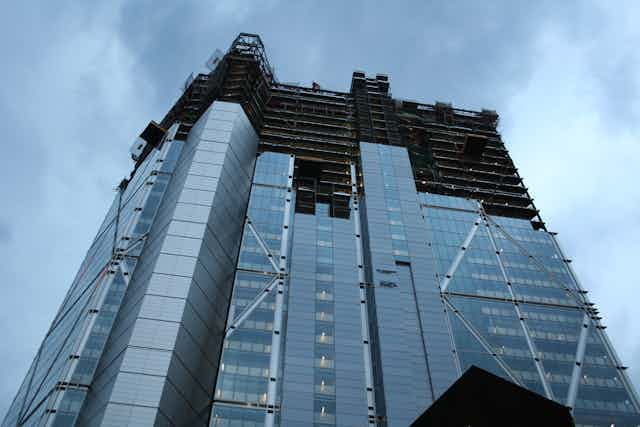Britain is currently experiencing a high-rise building boom. A staggering 436 new tower blocks (defined as those over 20 storeys) have been proposed, approved, are in planning, under construction or recently completed in London. Most of these developments – including one residential building reaching a staggering 75 storeys – are luxury apartments.
Things certainly have changed: high-rise apartments were once best known as a form of council housing. Throughout the 1960s, some tower blocks rose to dizzying heights of 33 storeys. But they fell out of favour throughout the 1970s and 1980s, when they suffered a serious cultural backlash.
Most famously, Alice Coleman’s Utopia on Trial claimed that high-rise estates were breeding grounds for crime – a view repeated almost exactly by the influential 2013 Create Streets report, and echoed throughout popular culture by novels such as J G Ballard’s High Rise. Just earlier this year, former Prime Minister David Cameron announced a “blitz” on “sink estates”, to remove the “brutal high-rise towers”.
Back in fashion
So for high rise buildings to once more be the height of fashion is a surprising development. What’s even more curious is that many of the old tower blocks are being replaced by similar – albeit more modern – high-rise designs. For instance, the eight-storey towers of London’s Woodberry Down estate are being replaced by luxury blocks reaching 30 storeys high.
The question is: why does the tower block of the 21st century represent progress, when the tower block of the post-war era was written off as a failure?
Earlier waves of high-rise housing came about as a result of the post-1945 welfare state. There were a few exceptions, such as Berthold Lubetkin’s 1930s luxury Highpoint blocks in Highgate, North London. But for the most part, post-war tower blocks were council developments, commissioned on the principle that everyone in society should have access to shelter.

The initial plan followed by local councils was to disperse the population of overcrowded cities, by rehousing some people in New Towns and low-rise suburban estates. Then, in the late 1950s, the drive to build upwards kicked in. This came about for several different reasons: shortages of building land outside and inside major urban areas, new building techniques, government subsidies for higher dwellings, and a desire to build strikingly modern housing.
Not everyone supported this move towards high-rise blocks – even within the Labour Party, who on the whole were far keener on building tall. A 1961 piece in the regional party newspaper Labour’s Northern Voice – now held in the Working Class Movement Library in Manchester – remarked that “common sense demands opposition to those who clamour for blocks in every conceivable spot”.

Academics also weighed in. After examining 15-storey blocks in the council estate of Barton Hill in Bristol, sociologist Hilda Jennings claimed in a 1962 study that the new flats were considered “unnatural” by “apparently the great majority” of local residents.
Geographer Pearl Jephcott’s 1971 study Homes In High Flats, which surveyed residents across several estates in Glasgow, Scotland, went even further. She found that tower blocks were near-universally thought to be “nae use for the bairns” (a poor choice for young children), because of the lack of play facilities and the need to use the lift to access the flats on most estates – although Jephcott did find that most residents believed their flats to be far more private than their old terraced houses or tenements.
Going down
By the mid-1960s, most social scientists believed that lower-rise, modern housing with wide “streets in the sky”, such as Park Hill in Sheffield, were far better for residents. Ironically, these “innovative” designs would become some of the most heavily criticised modern developments of the 1970s and 1980s – so much so that many were singled out for regeneration. Indeed, the Mozart Estate (itself a small-scale, “streets in the sky”-style estate) in west London became the centrepiece of regeneration efforts led by Alice Coleman herself.

By 1968, the collapse of the 22-storey Ronan Point block in East London destroyed the appetite for building high. But poor maintenance and a growing appreciation for Victorian housing from the 1970s may have finished the job. The popularity of high-rise housing had come to an end, and tall buildings were primarily constructed as offices for much of the 1980s and early 1990s.
So what changed? Some have pointed to the Tony Blair-era Labour government’s fascination with European cities such as Bilbao and Rotterdam, which influenced urban regeneration projects across Britain from 1997 to 2010. From Salford Quays, up north in Greater Manchester, to Southampton’s Ocean Village on the south coast of England, high-rise apartments were a key component of these regeneration efforts.
But rather than providing homes for benefits recipients, these apartments were – more often than not – luxury developments. In recent years, the combination of an inflated property market, a “new urbanist” high density aesthetic, and an increasing lack of building space (in London, especially) has driven the rapid high-rise boom.

While sections of new towers must be designated as “affordable” housing to secure planning permission, the proportion has been minuscule in several developments. Rather than subsidise the homes – and lifts – of less well-off residents, developers seek to maximise profits by attracting high-earning homeowners, and ensuring that they lose far less on maintenance costs.
The experience of the past suggests that high-rise can work – but only with sufficient investment. While the Spa Green Estate in Finsbury, London, is still in high demand after a much-needed refurbishment, a key theme from the memories of Glasgow’s Red Road Estate tenants following its demolition in 2015 was one of neglect.
It seems that this “unnatural” form of housing has become entirely normal. It must be, when a flat on the Woodberry Down development costs £1.2m.

